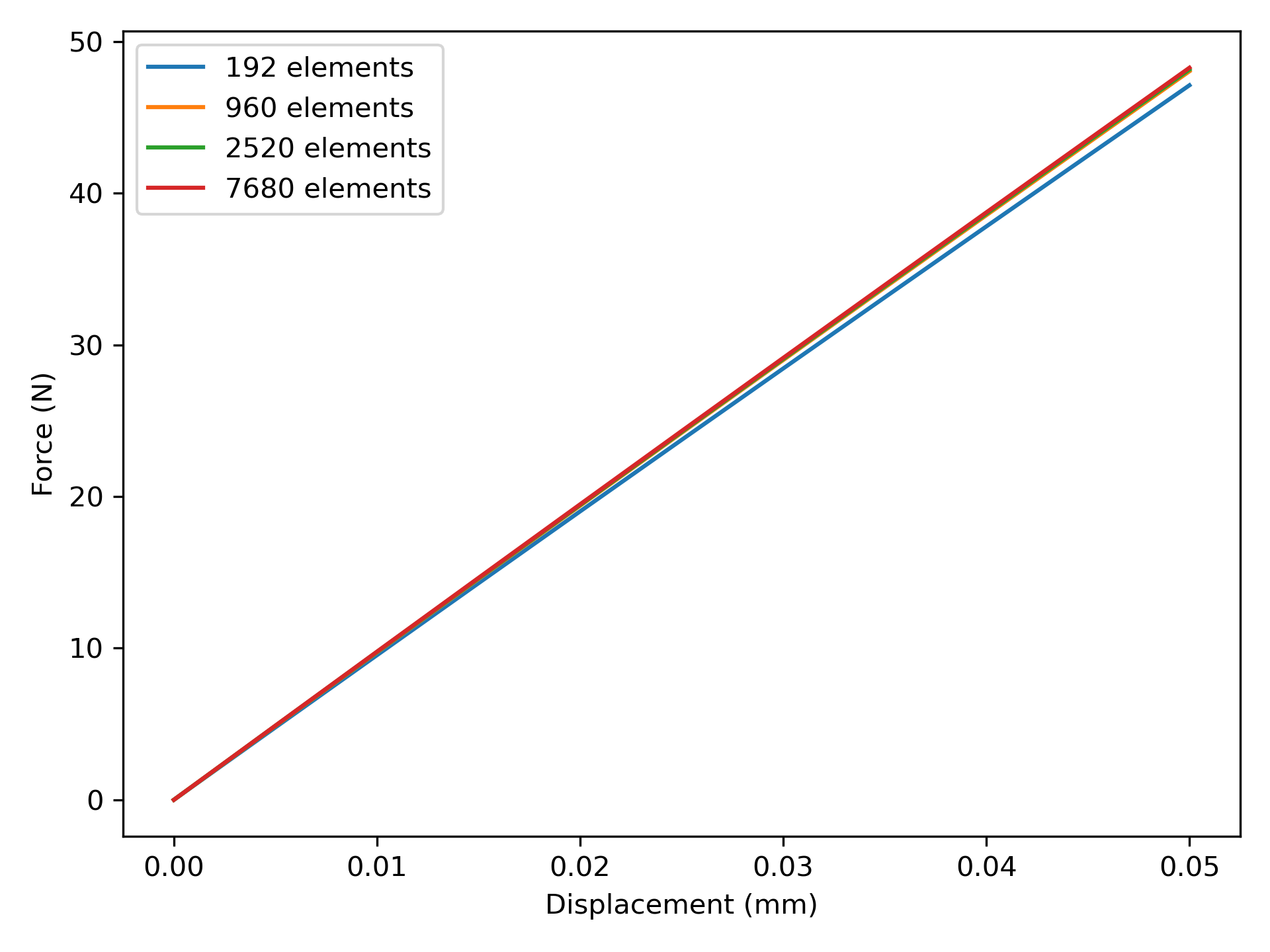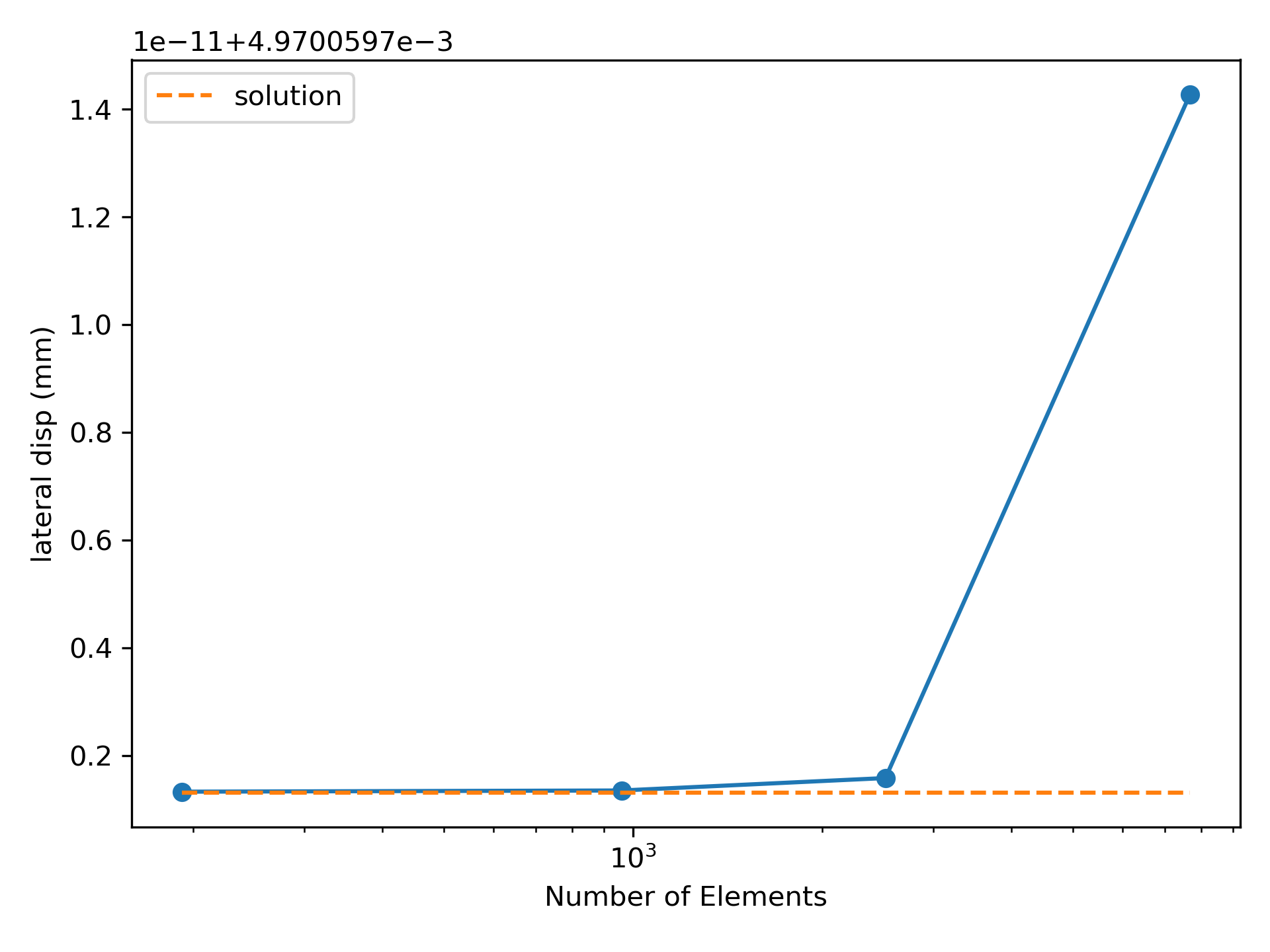Convergence of Tardigrade-MOOSE for uniaxial stress
Tardigrade-MOOSE is a finite deformation code. The linear elastic micromorphic constitutive model is geometrically nonlinear which may be considered an extension of the Saint Venant-Kirchhoff model [5]. As such, simulation results should be compared to analytical solutions in the finite deformation regime. A simple study is conducted that investigates the convergence behavior of Tardigrade-MOOSE for a set of classical linear elastic material inputs with similar loading and boundary conditions as described in the previous sections. A cylinder with 5 mm diameter and 5 mm height is displaced in the z-direction to produce a nominal strain of -1% with boundary conditions that result in a uniaxial stress state. The modulus of elasticity is 250 MPa, the Poisson ratio is 0.2, and the density is 2000 kg/m^3.
Refer to Solution to finite deformation linear elasticity for uni-axial stress for details of the analytical solution.
A user may find the model_package.Tardigrade_MOOSE.finite_stVK_calculation
script helpful for reproducing the relevant calculations.
It can be shown that the relevant stresses and forces for this problem are
Note
Tardigrade-MOOSE does not currently provide stress quantities evaluated in the current configuration including Cauchy stress.
Four meshes are considered for simulation in Tardigrade-MOOSE with
192, 960, 2520, and 7680 elements.
See the Tardigrade_convergence_study Sconscript for details of how this
workflow is setup, as well as the elastic_cylinder dictionary in the
model_package/Tardigrade_MOOSE/simulation_variables_nominal.py file
where input parameters are defined.
The mesh convergence analysis is setup as a parametric study. After simulations are initialized, exectuted, and post-processed, the force versus displacement and lateral displacement results are collected for each case.
The analysis may be exectuted using the following command:
$ scons Tardigrade_convergence
The --jobs=4 argument may be included to run each simulation concurrently.
The final force versus displacement plot is shown in Figure 22.

Fig. 22 Absolute value of force versus displacement results of Tardigrade-MOOSE convergence study
The final force results are -47.1203, -48.0434, -48.1549, and -48.2759 N for the
meshes with 192, 960, 2520, and 7680 elements, respectively.
The final force value for each mesh is plotted against the analytical
solution in Figure 23.
These results indicate that Tardigrade-MOOSE is converging to the
analytical force value of -48.3535 N.
See the docs/Tardigrade_convergence_all_force_displacements.csv
file for all force-displacement data.

Fig. 23 Final force versus analytical solution for Tardigrade-MOOSE convergence study
The total force depends on the final deformed area of the cylinder, so it is expected that the lateral displacements in the Tardigrade-MOOSE simulations agree with the analytical solution since the total force appears to converge. The lateral (or radial) stretch solved for this problem, following Eq. (13), is found to be \(\alpha_r = 1.001988\). The analytical lateral displacement may then be calculated as:
The final lateral displacements are sampled from the Tardigrade-MOOSE simulation results for each mesh
at the mid-height of the cylinder on the outer edge.
The resulting values are all within \(10^{-10} mm\) of the analytical
solution, which is finer than the precision expected from the solver.
The final lateral displacement values for each mesh are plotted against
the analytical solution in Figure 24.
See the docs/Tardigrade_convergence_all_lateral_displacements.csv
file for all lateral displacement data.

Fig. 24 Final lateral displacement versus analytical solution for Tardigrade-MOOSE convergence study